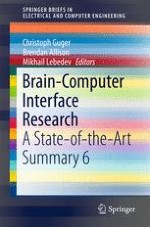2017 | OriginalPaper | Buchkapitel
Visual Cue-Guided Rat Cyborg
verfasst von : Yueming Wang, Minlong Lu, Zhaohui Wu, Xiaoxiang Zheng, Gang Pan
Erschienen in: Brain-Computer Interface Research
Aktivieren Sie unsere intelligente Suche, um passende Fachinhalte oder Patente zu finden.
Wählen Sie Textabschnitte aus um mit Künstlicher Intelligenz passenden Patente zu finden. powered by
Markieren Sie Textabschnitte, um KI-gestützt weitere passende Inhalte zu finden. powered by
